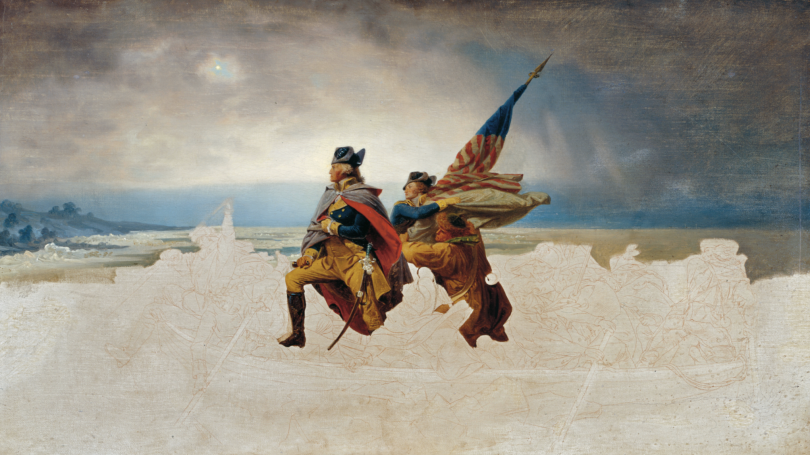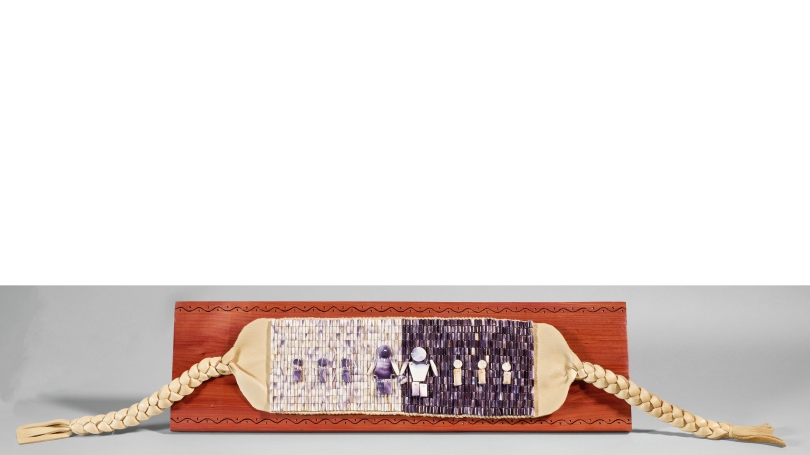MICHAEL HARTMAN, Jonathan Little Cohen Associate Curator of American Art
The Hood Museum of Art's 2023 exhibitions invite us to consider the role of art and artists in the construction of our shared history. What better way to begin this conversation than by hanging a study for Emanuel Leutze's iconic Washington Crossing the Delaware in the museum's Luise and Morton Kaish Gallery? Generously on loan from a private collection, this incomplete study features a painted portrait of George Washington standing above detailed figures outlined in graphite, revealing Leutze's artistic process.
The individuals below Washington include a Scottish immigrant and Black man at the front of the boat, as well as a Native American person at the rear. Leutze rightfully acknowledges the contributions of these figures to the American Revolution, but they are unequal—each is lower than Washington and placed at the boat's edges. While we can identify them with relative ease in the final painting, they are more difficult to find in this study. Women also played important roles in the American Revolution, but they are absent from this hierarchy of men, mirroring the inequalities of the time. Thinking deeply about how an artwork is arranged, who is present, where figures are situated, and who is absent, invites us to question how artists construct and critique ideas about US history.
Leutze, an American artist born in Germany in 1816, painted several versions of Washington Crossing the Delaware around 1850, nearly seventy-five years after George Washington's army attacked the British on Christmas Day, 1776. Living in Düsseldorf at the time, Leutze hoped his painting would inspire his demoralized German comrades after their failed 1848–49 revolutions, just as the success of Washington's crossing had rejuvenated a battered American Army. Leutze used this scene from the past to inspire the future, a future built upon the economic, gender, racial, and social inequalities that were written into the laws of the United States by Washington his contemporaries.
Several US painters traveled to Düsseldorf in the mid-nineteenth century to study with Leutze, including Albert Bierstadt and Eastman Johnson. Both artists are featured in Historical Imaginary. Johnson likely modeled for one of the figures in Leutze's painting, and Bierstadt's well-known paintings of the American West owed everything to his mentor. In 1859 Leutze introduced Bierstadt to John Floyd, the US secretary of war, who invited Bierstadt on his first journey into the western states and territories.
Alongside these historical works, contemporary artist Valerie Hegarty repurposes an iconic portrait of George Washington in George Washington (On a Stick). Hegarty says this work "creates a commentary on the formation of American identity, with the disfigured portrait revealing the return of repressed and darker elements of American history." Hegarty's luminous portrait grapples with how to represent Washington's violent legacy, instead of suppressing his role as an enslaver and his participation in demolishing Native American villages, as has been done so often in the past.
Leutze's painting connects past, present, and future, as does the wampum belt recently given to Dartmouth College by the Mohegan people when the college repatriated Samson Occom's papers. Occom was a citizen of the Mohegan Tribe and a Presbyterian cleric who traveled to England to raise the funds for Dartmouth's founding. Without his efforts, Dartmouth would not exist.
Wampum belts have long been exchanged between Indigenous and other nations. Differing from written treaties with fixed terms, wampum belts signify the beginning of a living relationship between two parties, and their intention to continually discuss and revisit their mutual obligation to one another. According to Mohegan medicine woman and tribal historian Melissa Tantaquidgeon Zobel, "the purple beads signify a history of conflict, and the white beads symbolize cleansing." Thus, this belt "is a joining of two peoples who have been in conflict but are now one in friendship."
This legacy of conflict, storytelling, and a move toward resolution swirl around Leutze's study in the gallery. Revisiting historical artworks, asking new questions of them, and thinking about the contexts in which they were made invites us to join in a broader conversation about how history and historical images inform our understanding of the present. Through this process, can we marshal this usable past to create a forward-looking future?


